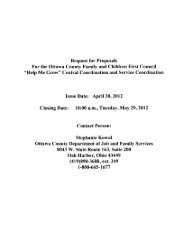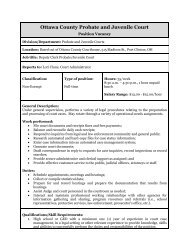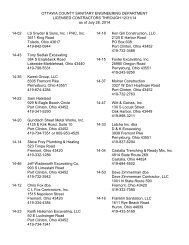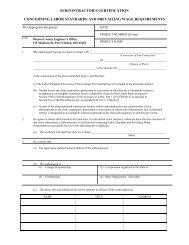ottawa county sewer district wastewater rules and regulations for ...
ottawa county sewer district wastewater rules and regulations for ...
ottawa county sewer district wastewater rules and regulations for ...
Create successful ePaper yourself
Turn your PDF publications into a flip-book with our unique Google optimized e-Paper software.
ASSESSMENT METHOD: The garage is an existing improvement with a<br />
permanent foundation. The use of the garage is directly related to the use<br />
of the adjoining lot. There<strong>for</strong>e, the house lot frontage <strong>and</strong> the garage lot<br />
frontage are combined as one (1) frontage. This total frontage shall be used<br />
with a property status equal to #1.<br />
3. A lot is non-buildable if the cost <strong>for</strong> improving the lot to a buildable status<br />
exceeds twenty percent (20%) of the total average cost ($100,000.00) of a house.<br />
(Not applicable where a lot has an existing improvement with a permanent<br />
foundation). The following is an example of this rule:<br />
a. Case - One owner owns two (2) lots beside each other. One lot has a house<br />
<strong>and</strong> the other lot has very steep hilly slopes with rock out croppings.<br />
To build on this lot would require rock excavation of 1,667 cubic yards<br />
(15' x 30' x 100'). The cost to excavate the rock is $83,333.00 ($50.00 per cy).<br />
ASSESSMENT METHOD: The cost <strong>for</strong> improving the lot to be buildable exceeds<br />
$20,000.00. There<strong>for</strong>e, the lot is nonbuildable <strong>and</strong> the frontage will be added<br />
to the adjacent house lot frontage. The total frontage will be used with a<br />
property status equal to 1.<br />
4. A lot is non-buildable if there is a lack of frontage to build on compared to the<br />
zoning <strong>regulations</strong> <strong>for</strong> the same subdivision. The following is an example of<br />
this rule:<br />
a. Case - A particular subdivision has a typical lot width of 50 feet. There is a<br />
50 foot lot located between two (2) of the 50 foot lot owners which was split<br />
in half. Both owners, who are adjacent to the split lot, own 25 feet of the<br />
lot which was split.<br />
ASSESSMENT METHOD: The lot having 25 foot frontage does not have<br />
sufficient frontage to build on in accordance with the zoning <strong>regulations</strong><br />
<strong>for</strong> that subdivision. One of the adjacent owners has a house on his 50 foot<br />
lot. We combine the non-buildable 25 feet with the 50 foot lot. The frontage<br />
will be 75 feet with a property status equal to 1. The other 50 foot lot owner<br />
has an empty building lot. We combine the non-buildable 25 foot lot with the<br />
50 foot lot. The resulting frontage shall be 75 feet with a property status<br />
equal to 2.<br />
b. Case - A particular subdivision has a typical lot width of 60 feet. However,<br />
due to a property split or other cause, an individual parcel having a lot<br />
width less than 60 feet exists which, due to subdivision or Department of<br />
Health <strong>regulations</strong>, cannot be built upon. Further, the lots on either side<br />
of the individual parcel are owned by separate owners.<br />
ASSESSMENT METHOD: If the property can be developed once a public <strong>sewer</strong><br />
is available, the parcel shall be assigned a property status equal to 2 <strong>and</strong><br />
assessed. If the property still cannot be developed even though a public<br />
<strong>sewer</strong> is available due to subdivision restrictions, the parcel shall be<br />
assigned a property status equal to 4 <strong>and</strong> not be assessed.








